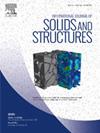Dynamic homogenization of random elastodynamic metamaterials using space–time Fourier transform
IF 3.4
3区 工程技术
Q1 MECHANICS
International Journal of Solids and Structures
Pub Date : 2025-03-27
DOI:10.1016/j.ijsolstr.2025.113339
引用次数: 0
Abstract
The dynamic homogenization of metamaterials with transfer matrix-based methods poses significant challenges due to an inherent branch ambiguity associated with the real part of the wavenumber. This problem is exacerbated in the presence of disorder (randomness) in cell geometry or material properties. Disorder necessitates larger domains for homogenization, which increase the range of wavenumbers with a branch ambiguity. To resolve this ambiguity, we utilize a Space–Time Fourier Transform (STFT)-based technique and extract primary parameters such as wavenumber and phase velocity, alongside secondary parameters including effective mass density, elastic modulus, and Willis-coupling terms for 1D multilayer media. A variation-based criterion is used to show that dynamic Representative Volume Element (RVE) can only be defined for the primary parameters. A sensitivity analysis is conducted to show that the coefficient of variation of secondary parameters is not only much higher than that of primary parameters, but also does not decrease by increasing the Statistical Volume Element (SVE) size. Our simulations predict the appearance of minor bandgaps induced by disorder. Phenomena such as blue-shift, widening, and merging of bandgaps are observed in random realizations. The STFT technique predicts homogenized parameters in both passbands, bandgaps, and can naturally be extended to higher dimensional metamaterials.
基于时空傅里叶变换的随机弹性动力超材料动态均匀化
由于与波数实部相关的固有分支模糊性,基于转移矩阵的方法对超材料的动态均匀化提出了重大挑战。在细胞几何或材料属性中存在无序(随机性)时,这个问题会加剧。无序需要更大的均匀化域,这增加了具有分支歧义的波数范围。为了解决这种模糊性,我们利用基于时空傅立叶变换(STFT)的技术,提取主要参数,如波数和相速度,以及次要参数,包括有效质量密度、弹性模量和一维多层介质的威利斯耦合项。基于变化准则表明动态代表性体积元(RVE)只能为主要参数定义。灵敏度分析表明,二次参数的变异系数不仅远高于一次参数,而且随着统计体积元(SVE)大小的增加,二次参数的变异系数也不减小。我们的模拟预测了由无序引起的小带隙的出现。在随机实现中可以观察到诸如蓝移、拓宽和合并带隙等现象。STFT技术预测了两个通带和带隙中的均匀化参数,并且可以自然地扩展到更高维度的超材料。
本文章由计算机程序翻译,如有差异,请以英文原文为准。
求助全文
约1分钟内获得全文
求助全文
来源期刊
CiteScore
6.70
自引率
8.30%
发文量
405
审稿时长
70 days
期刊介绍:
The International Journal of Solids and Structures has as its objective the publication and dissemination of original research in Mechanics of Solids and Structures as a field of Applied Science and Engineering. It fosters thus the exchange of ideas among workers in different parts of the world and also among workers who emphasize different aspects of the foundations and applications of the field.
Standing as it does at the cross-roads of Materials Science, Life Sciences, Mathematics, Physics and Engineering Design, the Mechanics of Solids and Structures is experiencing considerable growth as a result of recent technological advances. The Journal, by providing an international medium of communication, is encouraging this growth and is encompassing all aspects of the field from the more classical problems of structural analysis to mechanics of solids continually interacting with other media and including fracture, flow, wave propagation, heat transfer, thermal effects in solids, optimum design methods, model analysis, structural topology and numerical techniques. Interest extends to both inorganic and organic solids and structures.

 求助内容:
求助内容: 应助结果提醒方式:
应助结果提醒方式:


